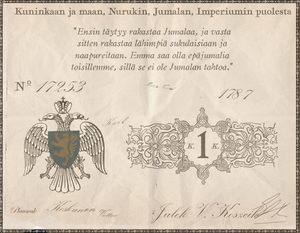Soravian korol

The korol (Soravian: Король, korol, literally "king"; /kɒrˈɒl/, plural koroliv) was the circulated currency of the Archduchy of Soravia and later the Soravian Empire from 1478 until it was replaced with the zolota by Eduard Olsov in 1862, with an exchange rate of 100 koroliv to the zolota. Due to Soravia's high population, it was one of the most circulated currencies in Euclea in the 19th century.
History
The establishment of the korol as a banknote regulated by the Royal Bank of Soravia was pushed by bank founder and financier Artur Shcherbak. It was the first paper-based currency circulated in Soravia, having replaced the hertso, which were mainly minted silver coins. Shcherbak wanted to introduce banknotes as a cheaper alternative to denoting larger amounts of money without the need for the mining of precious metals that had been required extensively for the minting of the hertso before the korol's establishment. In 1478, Shcherbak and the bank began to issue notes in exchange for government bullion and relendable bonds. The circulation and establishment of the new currency played a large part in paying off Soravia's debt during the reign of Jan II.
The korol continued to circulate gold and silver coins, however tin coins began to be circulated in the mid-16th century, and increased dramatically after the colonisation of Chistovodia. Historians have also claimed that the korol was one of the first examples of amount-specific note designs, including different quotes pertaining to Episemialist Sotirianity on each note, which ranged from 1 to 500 for a total of eight printed notes. Each note came with the phrase Для короля і країни, для Нурука, для Бога, для Імперії, Dlya korolya i krayiny, dlya Nuruka, dlya Boha, dlya Imperiyi printed at the top of the note. The phrase translates to "For King and Country, for Nuruk, for God, for the Empire" and was a popular phrase used extensively for propaganda purposes throughout Soravia.
It reached peak circulation in the 1770s, where Soravia reached its peak territorial extent after the Ten Years' War and the korol entered worldwide circulation, reaching Chistovodia, Kassar and Bahan. It enjoyed a stable period of little inflation entering the 19th century, before excessive spending by the monarchy, particularly by emperors Ivan V and VI, inflated the korol to around 45% its original value by 1850. The War of the Triple Alliance and subsequent First Soravian Civil War saw inflation shoot up to historic highs by 1860, by which its worth had virtually been eradicated with the lack of stable government at the time. In 1862, Olsov announced the abolishment of the korol and brought in the new zolota, exchanging it at 100 koroliv for one zolota. The korol had a brief grace period to allow for its exchange and was removed from legal tender on January 15, 1863.
Design
All notes of the korol followed a general design pattern for much of its history. The phrase "For King and Country, for Nuruk, for God, for the Empire" was printed at the top of all issued korol notes, and was accompanied with an Episemialist-related quote that differed from note to note. Most korol notes, excluding the 500, contained a picture of the royal Soravian coat of arms, and sometimes included the arms of the ruling house of Soravia, although this was rare and only included on notes printed on the birthday of a ruling king. The 500 note included a portrait of the King, redone every three to four years. All notes included early serial numbers, their date of print, location of print, value, as well as the name and signature of the current Chief of the Royal Bank.